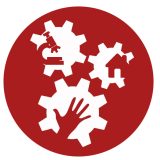There were many questions from employees about what they could do to cope with certain challenges in their personal life that impacted on work and conversely. Here, the information relates primarily to the link between the employee’s private life preferences and the employment relationship with the employer.
Creating an information and advice resource (e.g. desk) for the integration of work and personal life
Problem (evidence)
Aims/objectives
To make it easier for employees to handle situations that combine personal and work life so as to increase satisfaction at work and facilitate private life. To develop a resource that explains issues around work and personal life integration (within the wider legal context) in a simple and comprehensive way.
Resources
Collaboration of the PLOTINA project team, HR department, Legal department, IT team and management support (Head of Departments).
Creation of an intranet section, where all employees can log in, named: When private life and work at NIC meet.
Time allocation for gathering information and putting it online.
IT support for website analysis, number of unique visitors etc.
Legal department time for interpretations of legal practices, laws, regulations and policies.
Brief outcomes
More than a third of employees accessed the site the day within the first two days of its online launch.
Employees were also invited by e-mail to request further work and personal life integration information which was used to refine the information on the intranet site.
Key area
Work and personal life integration
Type of action
Availability of supports/resources
Organization
Kemijski Inštitut, National Institute of Chemistry
Research institute
Action level of implementation
Researchers/professors and technical and administrative staff
Implementation
Creation of an information point on NIC’s intranet where information for work and personal life integration is provided. Topics included: (i) My baby is a first-grader; (i) I want to move; (iii) My baby is sick and needs (my) care; (iv) I’m pregnant; (v) I have a baby; (vi) I want to work part time; (vii) I adopted a baby; (viii) I went back to work, breastfeeding my baby; (ix) my family member died. Sources for further information and a NIC contact person are provided in case further information is needed.
Challenges
The process has been time-consuming as it required understanding and interpreting relevant legislative framework.
We wanted the information as broad as possible, but at the same time did not want to burden the employees with legal language and terminology.
In the neo-liberal capitalist-oriented world governments, certain rights often reduce, under different pretexts.
It is necessary to monitor developments concerning employees in connection with their private lives in relation to the rights exercised by the employer, and keep them informed of any changes.
Tips/strategies – Lessons learnt
Tailor information and posts according to the questions that employees asked for (if there is only one interested person for a specific topic, there is certainly someone else who would need this information too).
More detailed Outcomes/Impact
The intranet site has been a much-appreciated resource.
There were no responses via email to an invitation by the employees for more examples of work and personal life integration that could be added.
Evaluation
We used google analytics to see the number of clicks, views and unique visitors on the webpage.
Reflection: what we would do differently
Send an email to employees announcing that there was a new post on the intranet and highlight what this post is about.
A section of the intranet page, similar to a forum, should be added so employees can get an automatic notification to their email when the site is updated with a new topic.
Unintended consequences
It seems that the website has generated informal debate on work life balance and especially the potential stigmatization of men taking paternity leave.


